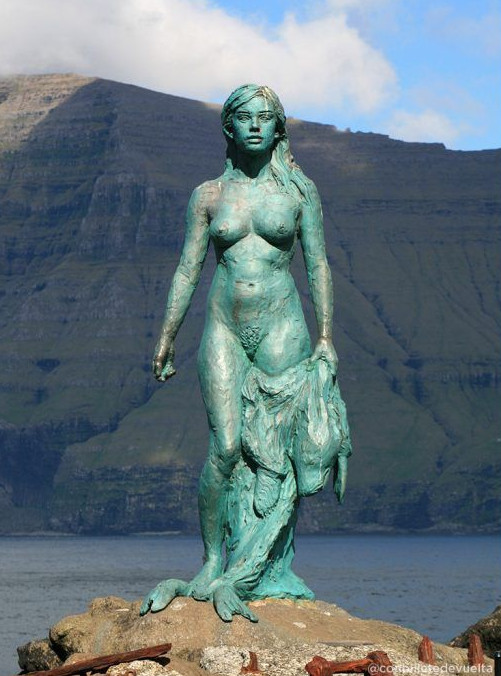
Published 2025-03-30
Keywords
- seal-folk stories,
- anthropocene,
- multi-species ethics
Copyright (c) 2025 Sarah E. McFarland (Author)

This work is licensed under a Creative Commons Attribution-NonCommercial-NoDerivatives 4.0 International License.
How to Cite
Abstract
This article deploys the inspirational figure of the selkie toward emphasizing non-hierarchical and sustainable co-existences between various species, ecosystems, and human beings, a necessary perspective in light of climate change, biodiversity loss, and species extinctions. The selkie wife story exposes the consequences of exceptionalist hierarchies, including those that structure nature as subordinate, animals as subordinate, and women as subordinate. Challenging this discriminatory thinking, the seal folk model accomplishes at least four things that are vital to its function as a traditional Irish folktale and to the ethical considerations it produces in the self-conscious Anthropocene. At its foundation lies a flexible worldview that accepts species ambiguity, contrasting with representations of biological others that fix their bodies as landscapes of control and abuse; the story itself is a warning against arrogance and domination, and is a rebuke of imperialism; and finally, it develops a clear lesson about how to be a proper person. Here I radically renegotiate human exceptionalism and the ontologies that illusion supports by turning to selkie myths and other stories of shapeshifting women to imagine alternative ways of thinking and living in the self-conscious Anthropocene in productive and collaborative ways.
References
- Barad, Karen. Meeting the Universe Halfway: Quantum Physics and the Entanglement of Matter and Meaning. Durham: Duke UP, 2007.
- Best, Andy. “Imagining Godzilla: An Art Research Network Platform.” In Situating Sustainability: A Handbook of Contexts and Concepts, edited by C. Parker Kreig and Reetta Toivanen, 293-330. Helsinki UP, 2021.
- Boland, Eavan. Outside History: Selected Poems 1980-1990. W.W. Norton, 1990.
- Calarco, Matthew. “Identity, Difference, Indistinction.” CR: The New Centennial Review 11,2 (Fall 2011): 41-60.
- Chakrabarty, Dipesh. “The Climate of History: Four Theses.” Critical Inquiry 35, 2 (Winter 2009): 197-222.
- Challenger, Melanie. How to Be Animal: A New History of What It Means to be Human. Penguin, 2021.
- Colebrook, Claire. The Death of the PostHuman: Essays on Extinction, Volume One. Open Humanities P, 2014.
- Darwin, Charles. Darwin Correspondence Project. “Letter no. 2647,” https://www.darwinproject.ac.uk/letter/?docId=letters/DCP-LETT-2647.xml
- Deleuze, Gilles and Félix Guattari. A Thousand Plateaus. Translated by B. Massumi. U Minnesota P, 1987.
- Estés, Clarissa Pinkola. Women Who Run with the Wolves: Myths and Stories of the Wild Woman Archetype. Balentine, 1992.
- Haraway, Donna. The Companion Species Manifesto: Dogs, People, and Significant Otherness. Prickly Paradigm, 2003.
- -----. Staying with the Trouble: Making Kin in the Chthulucene. Duke UP, 2016.
- Keller, Lynn. Recomposing Ecopoetics: North American Poetry of the Self-Conscious Anthropocene. U Virginia P, 2017.
- Kimmerer, Robin Wall. Braiding Sweetgrass: Indigenous Wisdom, Scientific Knowledge, and the Teachings of Plants. Milkweed, 2013.
- Le Couteur, Peter [Clair]. “Slipping off the Sealskin: Gender, Species, and Fictive Kinship in Selkie Folktales.” Gender Forum: An Internet Journal for Gender Studies 55 (2015): 55-82.
- Latour, Bruno. Facing Gaia: Eight lectures on the New Climatic Regime. Translated by Catherine Porter. Polity, 2017.
- McFarland, Sarah E. Ecocollapse Fiction and Cultures of Human Extinction. Bloomsbury, 2021.
- Møllegaard, Kirsten. “Global Flows in Coastal Contact Zones: Selkie Lore in Neil Jordan’s Ondine and Solveig Eggerz’s Seal Woman.” In Unsettling Assumptions: Tradition, Gender, Drag, edited by Pauline Greenhill and Diane Tye, 93-111. Utah State UP, 2014.
- Ní Dhomhnaill, Nuala. Rhoga Dánta. Translated by Michael Hartnett. New Island Publishers, 1993.
- Nixon, Rob. “The Anthropocene: Promise and Pitfalls of an Epochal Idea.” Edge Effects, 6 November 2014, updated 12 October 2019. https://edgeeffects.net/anthropocene-promise-and-pitfalls.
- Odell, Jenny. How to Do Nothing: Resisting the Attention Economy. Melville House, 2019.
- Ondine. Directed by Neil Jordan. Wayfare Entertainment, 2009.
- Russell, Richard Rankin. “W.B. Yeats and Eavan Boland: Postcolonial Poets?” In W.B. Yeats and Postcolonialism, edited by Deborah Fleming, 101-32. Locust Hill Press, 2001.
- Rustick, Susan M. “Held Hostage by the Anthropocene.” In Thinking about Animals in the Age of the Anthropocene, edited by Morten Tønnessen, Kristin Armstrong Oma, and Silver Rattasepp, 3-17. Lanham: Lexington Books, 2016.
- The Secret of Roan Inish. Directed by John Sayles. Jones Entertainment and Skerry Productions, 1994.
- Shotwell, Alexis. Against Purity: Living Ethically in Compromised Times. U Minnesota P, 2016.
- Song of the Sea. Directed by Tomm Moore. Cartoon Saloon, 2014.
- Tatar, Maria. “Introduction: The Odd Couple in Tales as Old as Time.” In Beauty and the Beast: Classic Tales about Animal Brides and Grooms from Around the World, edited by Maria Tatar, ix-xxx. Penguin, 2017.
- Thomson, David. The People of the Sea: A Journey in Search of the Seal Legend. Counterpoint, 2000.
- Urpeth, James. “Animal Becomings.” In Animal Philosophy, edited by Matthew Calarco and Peter Atterton, 101-10. Continuum, 2004.
- Weil, Kari. Thinking Animals: Why Animal Studies Now? Columbia UP, 2012.
- Williams, Joy. Harrow: A Novel. Knopf Doubleday, 2022.
- Williamson, Duncan. Tales of the Seal People. Interlink, 2005.
